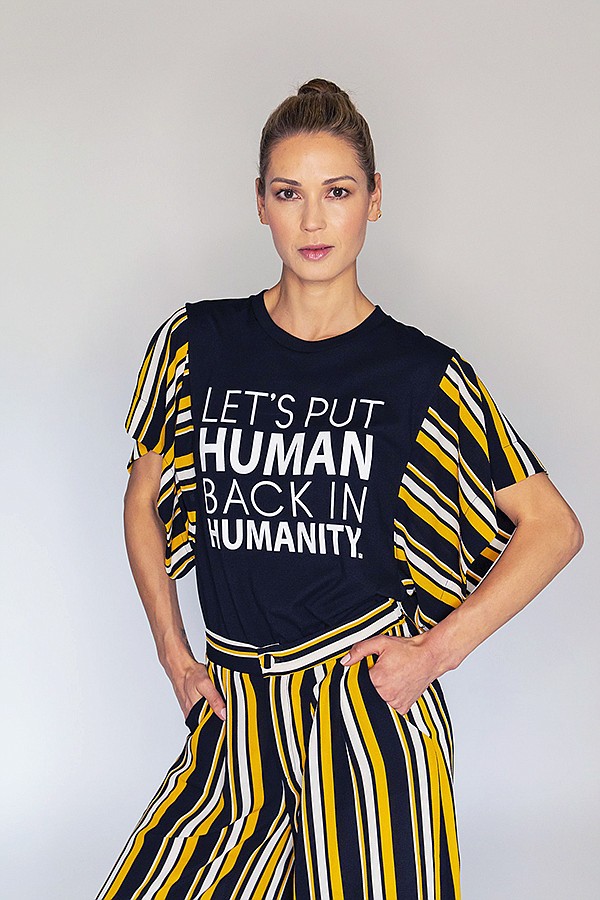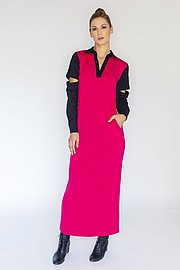KINDOM CLOSES LOOP
Kindom Plans To Expand By Making Less
For its second collection, the Los Angeles–headquartered brand Kindom decided against buying more fabric to produce the line yet adding more categories to the label.
Instead, the sustainable brand plans to upcycle or use materials from its debut line to make its second collection, called Kindom Circle. The 30-piece line was introduced at the Brand Assembly trade show in downtown Los Angeles Jan. 13–15. The collection will be sold on the brand’s direct-to-consumer site, kindomshop.com, and through a couple of independent boutiques—Le Pop Up on Abbot Kinney Boulevard in Los Angeles’ Venice area and The Canvas by Querencia Studio in Brooklyn, N.Y.’s Williamsburg area.
Kindom founder and designer Claire Powers, with Glynn Barrish-Carroll, who serves as the label’s operations and business-development chief, spent much of their careers working for fast-fashion brands and companies that made private-label clothing. The Kindom chiefs hope that their current project will serve as a model for others who want to build a brand that aims to stay ahead of fashion trends, work in harmony with the environment and pay the bills, Barrish-Carroll said.
Powers said that Kindom achieves its sustainability goals by following the United Nations’ environmental guidelines on sustainable practices. But Powers said that she keeps her own counsel when creating looks for Kindom styles.
“A lot of people say that sustainable is boring—it is basic clothing or missy,” Powers said. “But Kindom is street style and fashion.”
Kindom’s new line includes convertible styles. Sleeves from a top can be removed by unfastening buttons and reattaching them to the hems of a bottom to make a dress. “You can have four looks in one,” Powers said of the collection. A single convertible garment can be changed to fit people of different sizes. The convertible clothing also was intended to be gender fluid, made to fit both men’s and women’s bodies.
Silhouettes include wraps, unstructured pants, skirts and maxi dresses that can be worn for casual events or dressed up to go out in the evening, Powers said. Designs include florals, plaids, solids and some bohemian looks.
Kindom Circle’s collection also features some tops and T-shirts bearing slogans such as “Let’s Put Human Back in Humanity.” Wholesale price points for Kindom Circle range from $33 for a top to $110 for a dress. Materials used to make the brand include sustainable fabrics such as organic cotton and hemp, recycled polyester, dead-stock fabric and cloth made by indigenous communities from Southeast Asia, Africa and Latin America.
The collection also features some pieces that were made in collaboration with artists from the Canvas by Querencia Studio and with Anna Meier, an artist who makes natural dyes.
Customers of the brand include a wide range of consumers, but it especially interests young people committed to environmentalism, Barrish-Carroll said. “[Activist] Greta Thunberg is 17— she is inspiring everybody,” she said.
Barrish-Carroll said that the label plans to make sustainable private-label clothing and also consult with other manufacturers.
Powers and Barrish-Carroll advised that brands can get on the road to sustainability if they follow the United Nations’ 17 Sustainable Development Goals, which include the following tenets: using sustainable materials, using recycled materials, working toward closed-loop production by recycling and using packaging materials that are compostable and biodegradable.
To find compostable packaging, the Kindom chiefs worked with a producer of dog-waste bags, which worked with the apparel brand to produce compostable bags large enough to ship clothes in them.

























